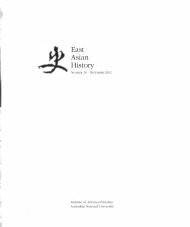(Donald Daniel Leslie) (PDF 4.7MB) - ANU
(Donald Daniel Leslie) (PDF 4.7MB) - ANU
(Donald Daniel Leslie) (PDF 4.7MB) - ANU
You also want an ePaper? Increase the reach of your titles
YUMPU automatically turns print PDFs into web optimized ePapers that Google loves.
82<br />
DONALD DANIEL LESLIE<br />
38 Jen Fang, Sbu-i-cbi (see n.14 above), pt2,<br />
p.8a. This version follows the HHS, with a<br />
few minor variations.<br />
39 InPai-cb 'uanbsueb-bai (seen.12 above),<br />
p.2313. This, I suggest, was the passage<br />
translated by Giles as (mistakenly) from the<br />
Cbu- p'u. Giles' translation is close: "A girl,<br />
who was bathing in the river Sheng, saw<br />
a section of bamboo come floating along<br />
with the stream. When it neared her,' she<br />
pushed it away; but it came back again, and<br />
then, hearing a sound from within, she took<br />
the bamboo and carried it home. On opening<br />
it, she discovered a little boy, who, on<br />
growing to man's estate, adopted Bamboo<br />
as his surname, and afterwards rose to be I<br />
ruler of the State."<br />
40 Tsang-k'o was formerly Ch'ieh-lan HM.<br />
This is presumably unconnected with the<br />
Ch'ieh-lan HM which is found in HHS 88<br />
and Wei-lueb ftB3 (in San-kuo-cbib 30) as<br />
a vassal state of Rome (and considered by<br />
Hirth (Friedrich Hirth, Cbina and tbe Roman<br />
Orient (Shanghai & Hong Kong, 1885; reprint<br />
ed., Chicago: Ares, 1975») and by <strong>Leslie</strong><br />
& Gardiner ["Roman Empire in Chinese<br />
sources'1 as Palmyra).<br />
41 The basic sources for Yeh-lang are: SC 116,<br />
HS 95, HHS 86, HYKC, and Scc. A summary<br />
is found in TPYL 791. Secondary works<br />
include Yeb-Iang k'ao, and Yeb-Iang sbibt'an.<br />
See also Yves Hervouet, Sseu-ma Siangjou,<br />
p.105.<br />
42 Forthese,seeSC 116 (and 117); Takigawa,<br />
Sbiki kaicbti koslxi, pp.5 ff. (and 59 ff.);<br />
Sbib-cb, pp.2993-4 (and p.3046); Watson,<br />
Grand bistorian, vol.2, p.291 (and pp.321-<br />
4). Also HS 95; Wang HSien-ch'ien, Han-sbu<br />
pu-cbu, pp.5397 ff.; Han-sbu, p.3839. See<br />
also Liu Lin, HYKC cbiao-cbu, pp.342-5,<br />
and Hervouet, Seu-ma Siangjou, pp.80 ff.<br />
Ssu-ma Hsiang-ju ii],;j:jm, the famous<br />
poet of the Former Han, was associated with<br />
this Chinese southern advance.<br />
43 Hervouet, Sseu-ma Siangjou, p.108;<br />
Streffer, "Das Capitel 86," p.117; Liu Lin,<br />
HYKC cbiao-cbu, p.340.<br />
Shu-i-chi 38<br />
Yeh-lang county is the name of a country of the Yi tribes in the far south-west.<br />
Formerly, a young girl was washing gauze when suddenly three pieces of<br />
bamboo floated between her legs. She heard from inside it a cry, and when<br />
she cut open the bamboo and looked inside, she found a male [child]. She<br />
returned home and brought him up. When he grew up he was warlike and<br />
set himself up as marquis of Yeh-lang, taking Chu [Bamboo] as his surname.<br />
In the 6th year of Yuan-ting j{jlIri [111 BCE] of the Emperor Wu, the southwestern<br />
Yi tribes were pacified and made into Tsang-k'o commandery. The<br />
marquis of Yeh-lang surrendered and the Emperor bestowed jade fHHS:<br />
"kingly"-better] insignia upon him. Afterwards he died. The Lao [clan] of the<br />
Yi tribes took the Bamboo King as not made of flesh and blood, and all set<br />
up a shrine for him. The Bamboo King spirit of present-day Yeh-lang county<br />
is he.<br />
Sun-p'u 39<br />
In the time of [Emperor] Wu of the Han, a girl was bathing in the river Sheng<br />
Jg1, when she saw a section of bamboo come floating down the stream. When<br />
it neared her, she pushed it away; but it came back again, and then, hearing a<br />
sound from within, she took the bamboo and carried it home. On opening it,<br />
she discovered a little boy, who, when grown up, adopted Bamboo as his<br />
surname, and set himself up as king. The bamboo thrown into an open field<br />
grew into a forest.<br />
Some Notes to the Texts<br />
1. Places mentioned are: Yeh-Iang R (palt of the south-western Yi <br />
tribes, later incorporated as a county in China); Tun QW.J River (Sheng<br />
Jg1 River in SP), which is in Yeh-Iang; Yu f1 River (another name for Tun<br />
River) ; Tsang-k'o Mfij GfDl) commandery (part of Kuei-chou)40; Shu JU<br />
commandelY (Ssu-ch'uan area); Ch'u tf state of the Chou dynasty, west<br />
of Shu (Kuei-chou/Hu-pei area). The area concerned is on the border<br />
between Ssu-ch'uan and Kuei-chou, not far nOith of the Yun-nan border<br />
and of Yung-ch'ang 7k county (in Yun-nan, on the route from the<br />
Roman Empire to China, second century CE).41<br />
2. People mentioned are Emperor Wu If-t of Han (14O-B6 BCE); King Wei<br />
of Ch'u tf (339-328 BCE); Tang Meng (who established Tsangk'o<br />
commandery between 135 and 109 BCE); WU Pa IW, Commander<br />
of Tsang-k'0.42<br />
3. Dates given are 111 BCE (during the reign of Emperor Wu); the period<br />
339-328 BCE. We might reconcile these dates by pointing out that several<br />
of the texts fairly clearly make the origin of the story and the girl bathing<br />
in the river much earlier than the historical reference to the Yeh-Iang king<br />
enfeoffed by Emperor Wu. As Helvouet, Streffer and Uu Un point out,43<br />
there is no certainty that the Bamboo King is the Yeh-Iang marquis or king
















